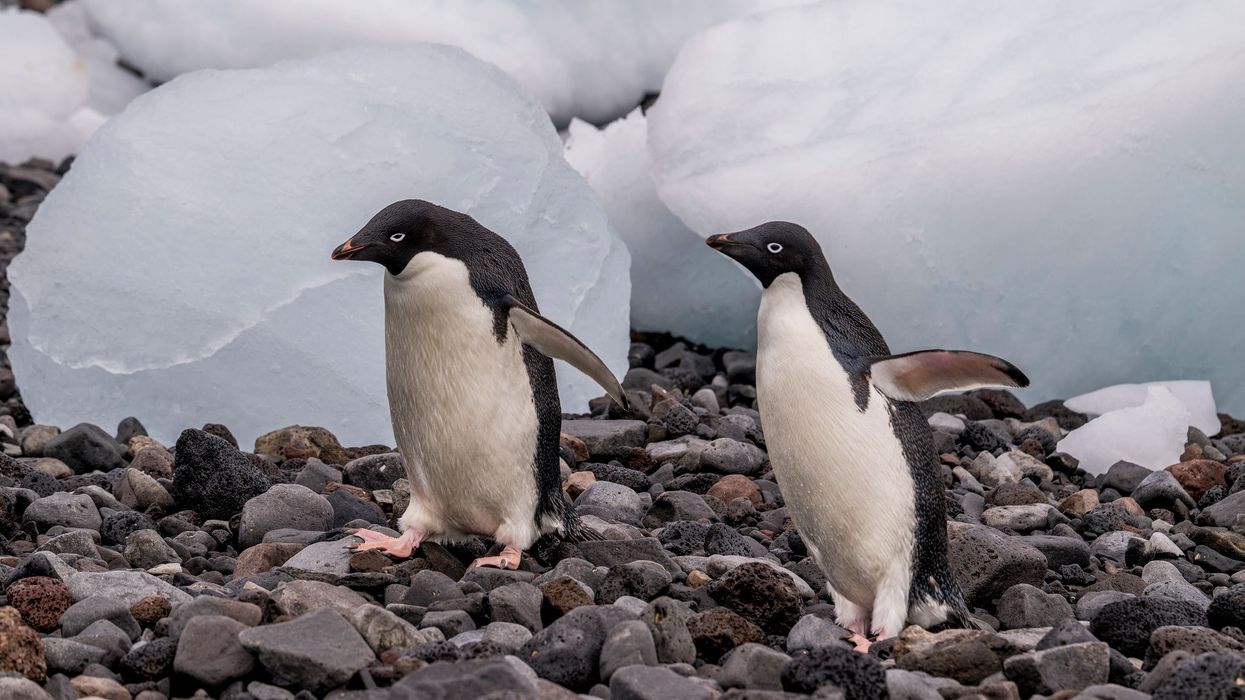(CNN) — Antarctic sea ice has reached record low levels for the second time in two years, with some scientists alarmed that dramatic drops are a signal the climate crisis may now be more clearly influencing this vast, complex, and isolated region.
The sea ice that fringes Antarctica dropped to just 737,000 square miles (1.91 million square kilometers) on February 13, according to the National Snow and Ice Data Center, or NSIDC, below the previous record of 741,000 square miles (1.92 million square kilometers) set on February 25 last year.
Sea ice could still shrink further; the lowest level of the southern summer may not be reached for more than a week.
The last two years mark the only time that sea ice levels have dipped below 2 million square kilometers since satellites began monitoring it in 1978.
It's "not just 'barely a record low,'" Ted Scambos, a glaciologist at the University of Colorado Boulder, told CNN. "It's on a very steep downward trend."
Unlike the Arctic, where the rate of sea ice loss has followed a fairly consistent downward trajectory as climate change accelerates, Antarctic sea ice extent has swung up and down, making it harder to figure out how the continent and its surrounding ocean are responding to global heating.
The two polar regions are very different. While the Arctic is an ocean surrounded by continents, Antarctica is a continent surrounded by the ocean — this means its sea ice can grow outward, unconstrained by land. Antarctic ice tends to be thinner than Arctic ice, with greater highs in the winter and steeper declines in the summer.
Climate models projected declines in Antarctic sea ice that were similar to the Arctic, but until recently the region was behaving completely differently than those models predicted.
It hit a record high for winter sea ice extent in 2014 when it reached 7.76 million square miles, which seemed to support the idea that the Antarctic may be relatively insulated from global warming.
But in 2016, something changed. Scientists began observing a steep downward trend.
At first, some put it down to the usual variability of this vastly complex continent, with its diverse, intertwined climate systems. But after two low sea ice records in a row, scientists are becoming concerned.
"The question is, has climate change reached Antarctica? Is this the beginning of the end? Will the sea ice disappear for good in the coming years in the summer?" Christian Haas, head of the Sea Ice Physics Research Section at the Alfred Wegener Institute in Germany, told CNN.
Several factors may feed into why sea ice is so low, including winds, ocean currents, and ocean heat.
Air temperatures have been higher than usual in parts of the Antarctic, around 1.5 degrees Celsius above the long term average.
Another important consideration is the belt of westerly winds which circle Antarctica, known as the Southern Annular Mode. These winds, which can increase sea ice melt, have been stronger than usual, according to the NSIDC, and added to weather conditions that pump warm air to the region.
The strength of the winds has been linked, in part, to the increase of planet-heating pollution as well as the hole in the ozone layer above the continent.
There are also suggestions that sea ice may be melting because of warmth trapped just below the surface of the ocean, Scambos said.
"Basically, you're getting heat stirred into the upper layer [of water] around the Antarctic," he said. If that theory holds up, and is linked to the general warming of the oceans, "then that has big implications for the stability of the Antarctic ice sheet."
The disappearance of sea ice can have cascading effects in Antarctica and beyond.
While it doesn't directly affect sea levels, because it is already floating in the ocean, the loss of the fringe of sea ice around the Antarctic leaves coastal ice sheets and glaciers exposed to waves and warm ocean waters, making them much more vulnerable to melting and breaking up.
An altered Antarctic landscape could have significant impacts on its wildlife, from the microorganisms and algae that prop up the food chain — food for krill which, in turn, feed many of the region's whales — to the penguins and seals that rely on sea ice for feeding and resting.
Parts of Antarctica have been seeing alarming changes for a while.
The Antarctic Peninsula, a spindly chain of icy mountains which sticks off the west side of the continent like a thumb pointing toward South America, is one of the fastest warming places in the Southern Hemisphere.
Carlos Moffat, an oceanographer at the University of Delaware, who has just returned from a research trip to the Antarctic Peninsula, told CNN that the low sea ice and very warm ocean temperatures they found "are dramatically different from what we have observed in the last few decades."
Moffat, who visits the region every summer as part of the Palmer Long-Term Ecological Research, said: "This year's conditions are against a backdrop of long-term change in this region of Antarctica."
Last year, scientists said West Antarctica's vast Thwaites Glacier — also known as the "Doomsday Glacier" — was "hanging on by its fingernails" as the planet warms, with rapid retreat possible over the next few years. Scientists have estimated global sea level rise could increase by around 10 feet if Thwaites collapsed completely, devastating coastal communities around the world.
It's too early to say whether the record sea ice decline is the new normal or whether it will bounce back, and Antarctica is known for its significant swings. The NSIDC points out that: "While 2022 and 2023 have had record low minimum extent, four out of the five highest minimums have occurred since 2008."
"It's going to take a while to unpack," Scambos said. "We're still reacting to a relatively sudden change. Certainly the last few years have been a dramatic exclamation point on a trend that was just developing after 2016."
Scientists will need at least another five years of data and observations, he estimated, but added: "It does feel like something has changed in the Antarctic and that things are fairly dramatic."
Correction: This story has been updated to correct the name of Christian Haas. Furthermore, the last two years are only times in the satellite era that sea ice extent has fallen below 2 million square kilometers.
The-CNN-Wire
™ & © 2023 Cable News Network, Inc., a Warner Bros. Discovery Company. All rights reserved.
- Polar Bear Attacks May Be Linked to Climate Change, Experts Say ›
- January Temperatures Higher Than Average in 2023 ›
- Wednesday's Top Stories: Senator Menendez, El Niño Winter, Stopping a Shooting ›


















































